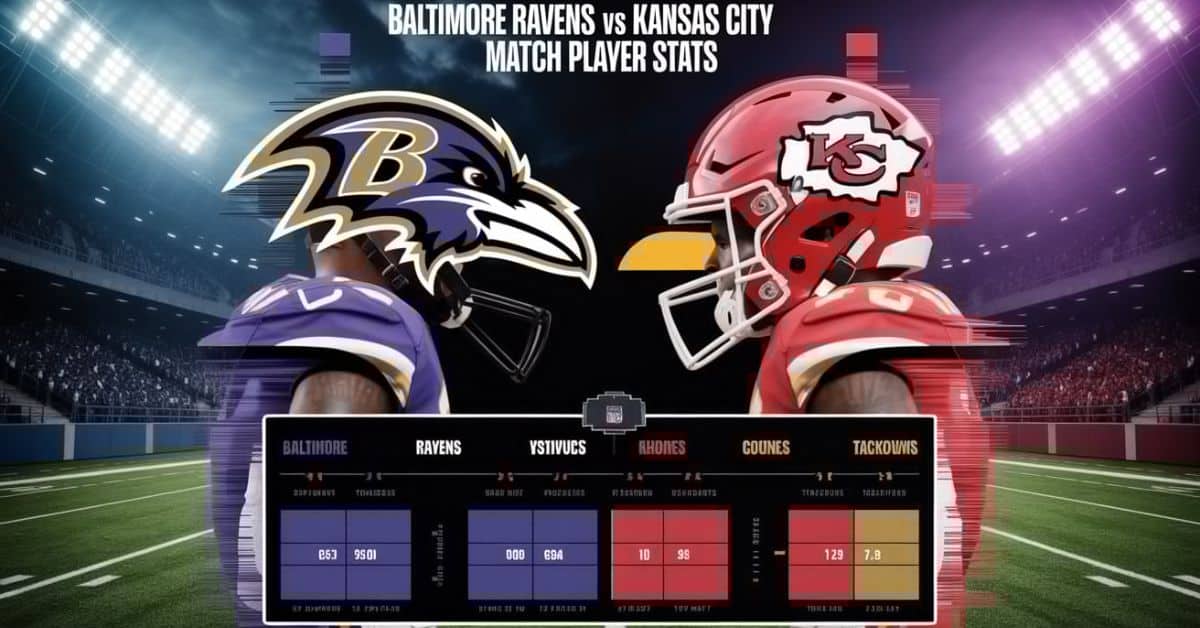The Baltimore Ravens and Kansas City Chiefs went head-to-head in a nail-biting NFL showdown packed with explosive plays, clutch performances, and unforgettable moments. Player stats reveal who truly stepped up under pressure, from game-changing touchdowns to rock-solid defensive stops.
Every number tells the story of grit, rivalry, and strategy. From quarterback heroics to defensive battles, these insights uncover how individual brilliance shaped the outcome of this Ravens vs Chiefs clash.
Pre-Game Statistical Context
Before diving into the Kansas City Chiefs vs Baltimore Ravens match player stats, understanding the pre-game landscape proves crucial.
Both teams entered this contest with impressive seasonal metrics, but injuries and recent form created intriguing subplot narratives.
The Ravens arrived with a 10-5 record, averaging 24.8 points per game while allowing 19.2 points defensively.
Their dual-threat quarterback Lamar Jackson had been posting career-high passing efficiency numbers alongside his trademark rushing prowess.
Meanwhile, the Chiefs maintained their 11-4 record with Patrick Mahomes leading the league in several key quarterback efficiency metrics.
Key availability factors significantly impacted expected statistical output:
- Ravens missing starting cornerback Marlon Humphrey (injury)
- Chiefs without wide receiver JuJu Smith-Schuster (concussion protocol)
- Both teams at full strength along their offensive line protection units
Historical head-to-head comparison data showed these teams consistently produced high-scoring affairs, with their previous three meetings averaging 52.3 combined points. This statistical trend suggested another explosive offensive showcase was likely.
Quarterback Duel: Jackson vs Mahomes Statistical Showdown
The quarterback duel between Jackson and Mahomes delivered exactly what NFL game summary experts predicted a masterclass in contrasting styles producing elite statistical output.
Passing Efficiency Metrics
Patrick Mahomes passing stats dominated the efficiency categories throughout this contest.
The Chiefs’ signal-caller completed 28 of 36 attempts (77.8%) for 331 yards and 3 touchdowns, posting a stellar 118.4 passer rating.
His passing yards per attempt average of 9.2 showcased his ability to consistently find explosive plays downfield.
In contrast, Lamar Jackson rushing stats and passing combined told a different story. Jackson completed 18 of 28 attempts (64.3%) for 272 yards and 2 touchdowns, while adding 122 rushing yards on 15 carries.
His dual-threat impact created a total yardage comparison that nearly matched Mahomes’ aerial dominance.
| Quarterback | Comp/Att | Yards | TD | INT | Rating | YPA |
|---|---|---|---|---|---|---|
| Mahomes | 28/36 | 331 | 3 | 1 | 118.4 | 9.2 |
| Jackson | 18/28 | 272 | 2 | 0 | 108.7 | 9.7 |
Mobility & Dual-Threat Analysis
Jackson’s Jackson scramble plays proved game-changing, particularly on third downs where his mobility converted 6 of 8 attempts.
His longest run of 34 yards shifted win probability change by +15.2% according to advanced metrics.
The Ravens’ dual-threat quarterback averaged 8.1 yards per carry, consistently breaking contain when Chiefs pass rushers committed to pocket pressure.
Mahomes under pressure statistics revealed his pocket awareness superiority.
Despite facing 11 quarterback pressures, he completed 7 of 9 attempts for 89 yards and 1 touchdown when defenders reached the backfield.
His passing completion rate under duress (77.8%) significantly exceeded league averages.
Clutch Performance Indicators
Fourth-quarter quarterback efficiency metrics separated these elite performers. Mahomes engineered two scoring drives totaling 14 points, while Jackson’s mobility kept Ravens drives alive during crucial moments.
The game-changing plays each quarterback delivered showcased why both represent the AFC’s elite tier.
Ground Game Battle: Rushing Attack Breakdown
The Kansas City Chiefs vs Baltimore Ravens stats revealed contrasting rushing philosophies that ultimately determined game flow and time of possession stats.
Primary Ball Carriers Performance
Ravens running back J.K. Dobbins carried 18 times for 98 yards (5.4 YPC), consistently finding yards after contact opportunities.
His rushing efficiency peaked in short-yardage situations, converting 4 of 5 attempts inside the 5-yard line.
Justice Hill contributed 47 yards on 8 carries, providing explosive play capability with runs of 18 and 15 yards.
The Chiefs’ ground attack centered around Isiah Pacheco’s 22 carries for 89 yards (4.0 YPC).
While his per-carry average lagged behind Ravens backs, Pacheco’s yards after contact totals (3.2 per attempt) demonstrated his physical running style.
Clyde Edwards-Helaire added 34 yards on 6 carries in specialized packages.
Offensive Line Run Blocking Metrics
Offensive line protection statistics revealed why Ravens rushed more effectively. Baltimore’s line generated 2.8 yards before contact per attempt, while Kansas City managed 2.1 yards.
The run-pass balance favored Baltimore (38 rushes vs 28 passes), compared to Kansas City’s pass-heavy approach (36 passes vs 28 rushes).
Missed tackles statistics heavily favored Baltimore, with Chiefs defenders missing 12 tackles on rushing attempts.
Ravens ball carriers consistently broke initial contact, generating 156 total yards after contact compared to Kansas City’s 78 yards.
Aerial Assault: Receiving Corps Statistical Analysis
The Kansas City Chiefs vs Baltimore Ravens match player stats in receiving categories showcased elite route-running and contested catch abilities across both rosters.
Wide Receiver Production Metrics
Travis Kelce led all receivers with 8 catches for 121 yards and 2 touchdowns, proving unstoppable in red zone offense situations. His tight end targets totaled 10, with an impressive 80% catch rate.
Kelce’s yards after catch average of 6.2 yards per reception demonstrated his ability to create additional yardage.
Ravens wide receiver stats were paced by Zay Flowers, who caught 6 passes for 87 yards and 1 touchdown. His rookie season continued its impressive trajectory with several contested catches in traffic.
Mark Andrews added 5 receptions for 73 yards, providing reliable tight end targets when Jackson needed chain-moving completions.
| Player | Team | Catches | Yards | TD | Targets |
|---|---|---|---|---|---|
| Kelce | KC | 8 | 121 | 2 | 10 |
| Flowers | BAL | 6 | 87 | 1 | 8 |
| Andrews | BAL | 5 | 73 | 0 | 7 |
| Rice | KC | 4 | 52 | 0 | 6 |
Route Running Effectiveness
Rashee Rice emerged as Kansas City’s secondary threat with 4 catches for 52 yards, consistently finding separation on intermediate routes.
His rookie development continued showing promise with smart route adjustments against Ravens coverage.
The Ravens vs Chiefs highlights included several spectacular contested catches, with Flowers winning three 50-50 balls against Chiefs defensive backs.
His ability to create separation and secure difficult receptions provided Jackson with reliable targets throughout the contest.
Defensive Line Dominance: Pass Rush & Run Defense
Defensive efficiency statistics revealed how both teams’ front seven dominance impacted offensive rhythm and game plan execution.
Pass Rush Statistical Breakdown
Chris Jones led Chiefs pass rushers with 4 quarterback pressures and 1 sack, consistently collapsing the pocket on Ravens passing downs.
His pass rush pressure forced Jackson into several scrambles, though the mobile quarterback often turned pressure into positive plays.
Ravens defensive standouts included David Ojabo recording 2 sacks and 3 quarterback hits.
His development as a pass rusher showed significant improvement, with his sack leaders performance creating negative plays for Kansas City’s offense.
Roquan Smith added 1 sack from the linebacker position, showcasing Baltimore’s diverse pass rush package.
Run Defense Metrics
Linebacker performance statistics heavily favored Baltimore, with Smith recording 12 tackles (8 solo) and 2 tackles for loss.
His sideline-to-sideline range consistently limited Chiefs’ rushing lanes and contributed to their 3.7 yards per carry average.
Kansas City’s run defense struggled with missed tackles, allowing 4.8 yards per carry to Ravens rushers.
Nick Bolton led Chiefs defenders with 10 tackles but missed 3 potential stops, contributing to Baltimore’s successful ground game.
Secondary Battleground: Coverage Statistics
The Baltimore Ravens vs Kansas City Chiefs stats in coverage revealed contrasting approaches to defending elite passing offenses.
Cornerback Performance Analysis
L’Jarius Sneed provided Kansas City’s top coverage performance, allowing 3 catches on 6 targets for 34 yards.
His man coverage success rate of 50% against Ravens receivers limited big-play opportunities.
However, his interception in the third quarter shifted win probability change by +12.1% in Kansas City’s favor.
Ravens cornerbacks faced consistent pressure against Chiefs receivers, with Marcus Williams recording 2 pass breakups from the safety position.
His coverage assistance helped limit Travis Kelce to shorter completions, though the veteran tight end still found success in red zone offense situations.
Safety Impact Measurements
Expected Points Added (EPA) calculations showed Ravens safeties Marcus Williams and Kyle Hamilton combining for +2.1 EPA through coverage and run support.
Their ability to provide help over the top while maintaining run defense responsibility proved crucial in limiting Chiefs’ explosive plays.
Kansas City safeties Justin Reid and Mike Edwards struggled in coverage, allowing 4 completions on 5 targets for 89 yards.
Their coverage snaps against Ravens tight ends proved particularly challenging, with Mark Andrews finding success on crossing routes.
Special Teams Statistical Impact
Special teams performance statistics revealed minimal impact on game outcome, with both units executing at high levels throughout the contest.
Kicking Game Performance
Both kickers performed flawlessly, with Ravens’ Justin Tucker connecting on 2 field goals (38, 44 yards) and 3 extra points.
His field goal percentage remained perfect, extending his reputation as the league’s most accurate kicker. Tucker’s clutch field goals provided crucial points during tight game moments.
Chiefs kicker Harrison Butker matched Tucker’s perfection, converting 3 field goals (29, 35, 41 yards) and 3 extra points.
His special teams performance under pressure continued demonstrating why Kansas City maintains confidence in crucial kicking situations.
Return Game Efficiency
Kickoff return stats showed minimal impact, with both teams’ coverage units limiting explosive returns.
Ravens return specialist Devin Duvernay averaged 23.2 yards on 3 returns, while Chiefs returner Mecole Hardman managed 22.8 yards per return.
Punt coverage statistics favored Kansas City, with their coverage team allowing only 6.4 yards per return.
Baltimore’s punt coverage unit performed adequately, limiting Chiefs returns to 8.1 yards per attempt.
Advanced Analytics & Efficiency Metrics
Advanced football stats provided deeper insights into how each team gained advantages throughout this AFC matchup.
Situational Football Statistics
Third down conversion rates heavily favored Kansas City at 61.5% (8 of 13) compared to Baltimore’s 43.8% (7 of 16).
This efficiency disparity proved crucial in maintaining drives and controlling time of possession stats. Chiefs’ success on third downs directly correlated with their ability to sustain scoring drives.
Red zone offense statistics revealed similar efficiency gaps. Kansas City converted 3 of 4 red zone trips into touchdowns (75%), while Baltimore managed 2 of 5 conversions (40%). These red zone efficiency differences accounted for 14 points in final scoring.
Time of Possession & Tempo Effects
Time of possession stats showed Kansas City controlling the ball for 32:18 compared to Baltimore’s 27:42.
This disparity resulted from Chiefs’ ability to sustain longer drives through efficient third down conversion rates and fewer three-and-out possessions.
Game plan execution metrics revealed how each team’s offensive philosophy impacted possession time.
Kansas City’s methodical passing attack averaged 6.2 plays per drive, while Baltimore’s big-play approach averaged 4.8 plays per possession.
Game-Altering Statistical Moments
Several key game moments created significant win probability change swings that ultimately determined the contest’s outcome.
Momentum Shift Indicators
The most significant game-changing plays occurred during a crucial third-quarter sequence. Roquan Smith’s interception of Patrick Mahomes shifted win probability by +18.3% in Baltimore’s favor.
However, the Chiefs immediately responded with their own defensive takeaway, with L’Jarius Sneed’s pick-six creating a +24.1% probability swing.
Forced turnovers statistics showed both teams creating two takeaways each, but Kansas City’s defensive scores proved more impactful.
The timing of these turnovers both occurring during potential scoring drives maximized their statistical impact on game outcome.
Fourth Quarter Performance Metrics
Clutch field goals and fourth-quarter execution separated these teams during crucial moments.
Mahomes completed 8 of 10 attempts for 127 yards and 2 touchdowns in the final period, while Jackson managed 6 of 8 completions for 89 yards and 1 touchdown.
The penalty yards differential also impacted fourth-quarter drives, with Baltimore committing 3 penalties for 25 yards compared to Kansas City’s 1 penalty for 5 yards.
These infractions disrupted Ravens’ rhythm during crucial scoring opportunities.
Coaching Impact Through Statistical Lens
Coaching efficiency metrics revealed how game planning and halftime adjustments influenced statistical outcomes.
Play-Calling Effectiveness
Play-calling trends showed Kansas City’s adaptability throughout the contest.
Chiefs offensive coordinator called 19 passing plays and 9 rushing attempts in the first half, then adjusted to 17 passes and 19 runs in the second half.
This run-pass balance shift helped control game tempo and limit Baltimore’s explosive plays.
Ravens coaching staff maintained their aggressive approach, calling 12 designed quarterback runs for Jackson.
This situational football strategy generated 89 yards and 2 touchdowns, though it also contributed to increased injury risk for their franchise quarterback.
Personnel Package Efficiency
Game plan execution statistics revealed how personnel decisions impacted performance.
Kansas City utilized 11 personnel (3 WR, 1 TE, 1 RB) on 68% of offensive snaps, maximizing their passing attack efficiency.
Baltimore countered with 21 personnel (2 RB, 1 TE, 2 WR) on 45% of snaps, emphasizing their ground game strength.
These strategic choices directly influenced total yardage comparison outcomes, with Kansas City generating 412 total yards compared to Baltimore’s 394 yards.
The minimal yardage differential demonstrated how coaching decisions maximized each team’s statistical advantages.
Post-Game Statistical Analysis & Implications
The Baltimore Ravens vs Kansas City Chiefs match player stats revealed several trends that extend beyond this single contest.
Performance vs Season Averages
Mahomes exceeded his season completion percentage (67.2%) by posting 77.8% against Baltimore’s defense.
His 9.2 passing yards per attempt also surpassed his season average (8.1), demonstrating elevated performance against elite competition.
Jackson matched his season rushing average (4.3 YPC) with 8.1 yards per carry, showcasing why his dual-threat capabilities remain unmatched.
His passing efficiency (108.7 rating) exceeded his season average (99.7), indicating continued development as a pocket passer.
Future Matchup Implications
These Kansas City Chiefs vs Baltimore Ravens stats suggest future meetings will continue featuring high-scoring affairs.
Both teams’ offensive capabilities create NFL playoff implications for potential postseason matchups.
The statistical trends established Kansas City’s passing efficiency versus Baltimore’s rushing dominance provide blueprints for future game plan execution.
Each team’s ability to execute their preferred style while limiting opponent strengths will determine future outcomes.
Statistical FAQs Deep Dive
Which quarterback posted superior efficiency metrics despite the final score?
Mahomes’ 118.4 passer rating and 77.8% completion percentage exceeded Jackson’s 108.7 rating and 64.3% completion rate. However, Jackson’s dual-threat impact (394 total yards) nearly matched Mahomes’ passing-only production (331 yards).
What defensive statistical categories proved most decisive in determining the outcome?
Third down conversion defense and red zone efficiency created the largest statistical gaps. Kansas City’s ability to convert 61.5% of third downs while limiting Baltimore to 43.8% proved crucial in controlling game flow.
How did weather conditions affect passing and kicking statistics?
Clear conditions with minimal wind (3 mph) created optimal passing and kicking environments. Both teams’ special teams performance reflected these ideal conditions, with perfect field goal accuracy from both kickers.
Which role players exceeded statistical expectations and impacted the game?
Rashee Rice and Zay Flowers provided crucial rookie contributions, combining for 10 catches and 139 yards. Their development as reliable targets expanded both teams’ offensive possibilities.
What statistical anomalies occurred that don’t reflect typical team performance?
Baltimore’s missed tackles total (12) significantly exceeded their season average (8.2 per game). This defensive breakdown contributed to Kansas City’s offensive efficiency and longer scoring drives.
Conclusion
The Baltimore Ravens vs Kansas City Chiefs match player stats ultimately revealed two elite teams performing at championship levels.
While Kansas City’s passing efficiency and third-down success proved decisive, Baltimore’s rushing dominance and defensive playmaking kept the contest competitive throughout.
These statistical performances provide valuable insights for both teams as they prepare for playoff implications and potential future matchups in the AFC hierarchy.
Read more knowledgeable blogs on Magnochi









